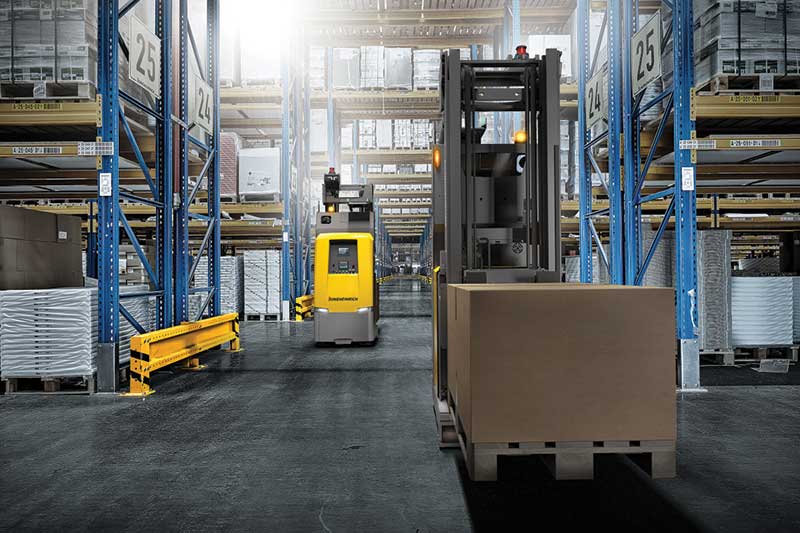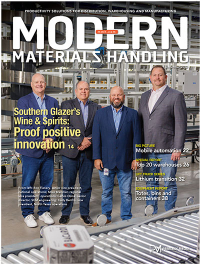Safety for automatic guided vehicle (AGV) environments
AGVs use sensors to avoid collisions, but best practices can still make the environments they will operate in as predictable and productive as possible.
When an operation decides to deploy a fleet of automatic guided vehicle (AGVs) lift trucks, the main driver typically centers on labor constraints, but enhanced safety also comes into play, says Colin Hutchings, director of solution development for Rocrich AGV Solutions.
“The labor component is the primary driver for AGVs, because it can be so difficult to find enough operators these days in many areas, especially for sites with multiple shifts. But in addition, many of our customers are out to provide the safest environments they can for their employees. AGVs definitely complement the industry trajectory toward safer work environments.” - Hutchings
In most AGV projects, adds Hutchings, the AGV lift trucks or tow tractors are automating a workflow that used to be executed with manually operated lift trucks or tow tractors, also known as tuggers. Generally, AGVs are safer in comparison to a manual lift trucks—their advanced sensors will stop a unit as soon as a risk is detected—but it still makes sense to establish best practices to make the environment the AGVs will operate in as clear of risks as possible, primarily to avoid disrupting the AGVs from their work, but also to help ensure the highest level of safety possible, especially when it comes to transfer positions where AGVs drop off or pick up loads.
The AGVs from Rocrich—a recently launched joint venture between Jungheinrich and Mitsubishi Logisnext America—use advanced sensors to provide a 360-degree field of view for safety, resulting in a safety performance level rating of known “PLd.”
PLd is the fourth highest level possible, which means they are extremely safe and not going to smack into objects on their own. However, underneath this technology, AGV lift trucks are still heavy equipment that can weigh three times more than a passenger car, so it’s best to exercise caution when working in close proximity, as you would a conventional lift truck.
In its projects, Hutchings says, Rocrich works with industrial and automation engineers, operations managers, and safety teams to design systems, including the number of AGVs needed to hit throughput targets and the best and safest routes, and particular points that may need safety markings or special attention during staff orientation.
“Particularly at the transfer positions, we need to make sure that operators know that an AGV is still, at the end of the day, a heavy piece of machinery that moves, so it’s important to be vigilant at all times, even if the safety systems are extremely robust,” Hutchings says. “We would consider the AGV transfer points to be areas that need close attention. We map out these locations, and show them to safety managers and operations teams and all the stakeholders, so that everyone understands how the AGVs are going to behave. But the good news is that AGVs behave very predictably.”
In general, says Hutchings, AGVs should have the “right of way” once routes are established. “We do provide orientation and training for every project we commission to make sure everyone understands how to work productively and safely alongside the automation.”
To enhance safety with coupling and decoupling carts from an AGV tow tractor, says Hutchings, Rocrich can add a sensor to detect if someone is behind the AGV, but in front of the carts. With this sensor, even if someone accidentally hits the user interface button to direct the AGV to continue, the AGV will not move if the sensor detects a person or object behind it.
Most facilities mark AGV paths or, conversely, paths pedestrians should stick to, as many do with manual trucks. Such floor markings or signage both ensure the system isn’t disrupted, as well as further reduce risks, even if the onboard sensing already makes the chance of an incident infinitesimally small.
With its AGVs, Rocrich also follows related safety standards, including ISO 3691-4, which sets forth some stringent requirements including in regard to safety sensing field of view, says Hutchings. Another pertinent safety standard for AGVs ANSI B56.5, adds Hutchings.
It is possible to configure and switch to alternate paths for AGVs in Rocrich’s software to provide flexibility in case an aisle or pathway is being worked on or otherwise needs to be temporarily avoided. But generally with AGV fleets, standard routes are a good thing, because they provide consistency to help avoid disruptions, as they also do for manually operated fleets.
“Standardizing the way that the materials handling process is structured is really important for both productivity and safety,” says Hutchings. “With the right planning and execution, an AGV system will outperform a manual operation in both categories.”

Article Topics
Jungheinrich News & Resources
Mitsubishi Logisnext partners with Jungheinrich to introduce Rocrich AGV Solutions Digitally assisted forklifts brew up safer production facilities Mitsubishi Logisnext Americas names 2024’s Dealers Of Excellence Jungheinrich provides ASRS solution for Güde Safety for automatic guided vehicle (AGV) environments Jungheinrich officially opens its new plant in the Czech Republic Rocrich AGV Solutions joint venture now in operation More JungheinrichLatest in Materials Handling
Geek+ and System Teknik deploy PopPick solution for pharmacy group Med24.dk Beckhoff USA opens new office in Austin, Texas Manhattan Associates selects TeamViewer as partner for warehouse vision picking ASME Foundation wins grant for technical workforce development The (Not So) Secret Weapons: How Key Cabinets and Asset Management Lockers Are Changing Supply Chain Operations MODEX C-Suite Interview with Harold Vanasse: The perfect blend of automation and sustainability Consultant and industry leader John M. Hill passes on at age 86 More Materials HandlingAbout the Author
Subscribe to Materials Handling Magazine

Find out what the world's most innovative companies are doing to improve productivity in their plants and distribution centers.
Start your FREE subscription today.
April 2024 Modern Materials Handling

Latest Resources












